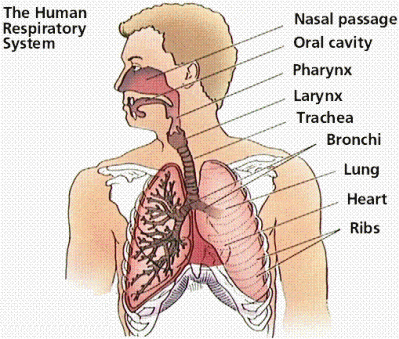HOW TO LOSE WEIGHT
Respiration
Respiration is the transport of oxygen from the outside air to the cells within tissues, and the transport of carbon dioxide in the opposite direction.
Cellular respiration: the metabolic process by which an organism obtains energy by reacting oxygen with glucose to give water, carbon dioxide and ATP (energy).
In air-breathing vertebrates such as humans, respiration of oxygen includes four stages:
Note that ventilation and gas transport require energy to power a mechanical pump (the heart) and the muscles of respitation, mainly the diaphragm. In heavy breathing, energy is also required to power additional respiatory muscles such as the intercostal muscles. The energy requirement for ventiliation and gas transport is in contrast to the passive diffusion taking place in the gas exchange steps.
Respiratory behavior is correlated to the cardiovascular behavior to control the gaseous exchange between cells and blood. Both behaviors are intensified by exercise of the body. However, respiratory is highly voluntary compared to cardiovascular activity which is totally involuntary.
http://www.cartage.org.lb/en/themes/Sciences/LifeScience/GeneralBiology/Physiology/RespiratorySystem/
HumanRespiratory/humrespsys_1.gif
Copy and paste the link above into your browser or scroll down for a diagram of the humanrespiratory system.
Cellular respiration: the metabolic process by which an organism obtains energy by reacting oxygen with glucose to give water, carbon dioxide and ATP (energy).
In air-breathing vertebrates such as humans, respiration of oxygen includes four stages:
- Ventilation, moving of the ambient air into and out of the alveoli of the lungs.
- Pulmonary gas exchange, exchange of gases between the alveoli and the pulmonary capillaries.
- Gas transport, movement of gases within the pulmonary capillaries through the circulation to the peripheral capillaries in the organs, and then a movement of gases back to the lungs along the same circulatory route.
- Peripheral gas exchange, exchange of gases between the tissue capillaries and the tissues or organs, impacting the cells composing these and mitochondria within the cells.
Note that ventilation and gas transport require energy to power a mechanical pump (the heart) and the muscles of respitation, mainly the diaphragm. In heavy breathing, energy is also required to power additional respiatory muscles such as the intercostal muscles. The energy requirement for ventiliation and gas transport is in contrast to the passive diffusion taking place in the gas exchange steps.
Respiratory behavior is correlated to the cardiovascular behavior to control the gaseous exchange between cells and blood. Both behaviors are intensified by exercise of the body. However, respiratory is highly voluntary compared to cardiovascular activity which is totally involuntary.
http://www.cartage.org.lb/en/themes/Sciences/LifeScience/GeneralBiology/Physiology/RespiratorySystem/
HumanRespiratory/humrespsys_1.gif
Copy and paste the link above into your browser or scroll down for a diagram of the human

